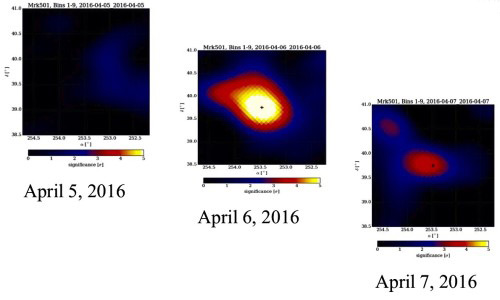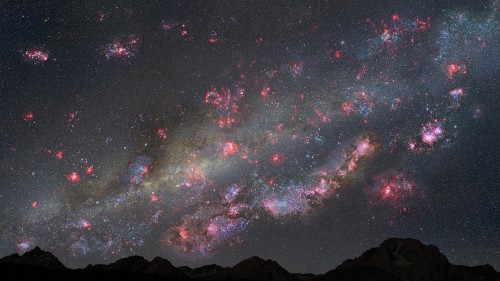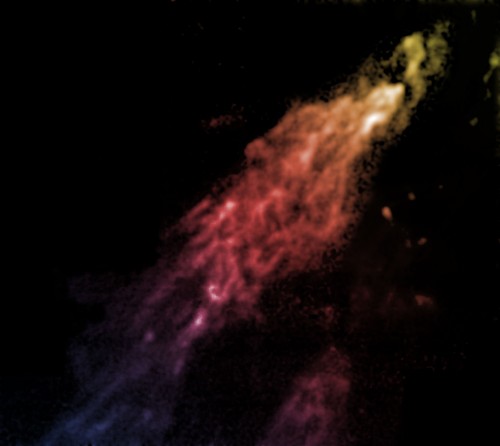Tag archives: galaxies
HAWC spots TeV gamma ray flare

Now you see it, now you don’t: a TeV gamma-ray flare spotted by HAWC. (Courtesy: Michelle Hui)
By Hamish Johnston at the APS April Meeting in Salt Lake City
Talk about luck. Just 10 days before the April Meeting the High-Altitude Water Cherenkov (HAWC) gamma-ray observatory lit up with the detection of a galaxy that produced large numbers of teraelectronvolt (TeV) gamma rays for just one day (see image).
Dubbed Markarian 501, HAWC astrophysicists believe that the flare could be driven by a supermassive black hole at the centre of the galaxy. However, they admit that they don’t really understand how such flares occur.
View all posts by this author | View this author's profile
Night visions, the sky 10 billion years ago and unexplained sounds from around the world

Good old days: the view from an Earth-like planet 10 billion years ago. (Courtesy: NASA/ESA/Z Levay (STScI))
By Hamish Johnston
This week’s Red Folder is inspired by a vision I had last night while I was putting out the garbage bins. I happened to look up at the sky just as the International Space Station (ISS) was travelling over Bristol. It was a very bright and impressive sight as it zipped overhead before disappearing at the eastern horizon. If you happen to be on an arc through northern Europe between Penzance and Poznań, you should also have a great view of the ISS this evening; you can find out when and where to look at the ISS Astroviewer website.
The ISS is one thing that you would definitely not see if you could look at the sky as it was 10 billion years ago – but have you ever wondered what that view would be? Zolt Levay at the Hubble Heritage Information Center has, and the above image is his vision of what the sky would look like from a hypothetical planet within a Milky Way-like galaxy 10 billion years ago. The work was inspired by a new collection of nearly 2000 images of galaxies as they appeared at that time in the history of the universe. Taken by a number of different telescopes including Hubble, “the new census provides the most complete picture yet of how galaxies like the Milky Way grew over the past 10 billion years into today’s majestic spiral galaxies”, according to NASA.
Coming soon(ish) to a galaxy near you

Image of Smith’s Cloud taken by the Green Bank Telescope. (Courtesy: Bill Saxton, NRAO/AUI/NSF)
By Margaret Harris at the AAAS meeting in San Jose
A giant cloud of hydrogen gas is barrelling towards the Milky Way faster than the speed of sound, and dark matter may hold it together long enough to produce a spectacular outburst of new stars in the night sky – but not for another 30 million years.
The cloud – which is known as Smith’s Cloud after Gail Bieger-Smith, who discovered it as an astronomy student in 1963 – is one of several starless blobs of hydrogen known to exist in the space between galaxies. According to Felix “Jay” Lockman, principal scientist at the US National Radio Astronomy Observatory’s Green Bank Telescope, such gas clouds are, in effect, “construction debris” left over from an earlier age of galaxy formation. “These are parts for remodelling your house that didn’t arrive by the time the contractor left,” Lockman told an audience at the 2015 AAAS meeting in San Jose, California.
Through two mirrors, brightly

Hubble’s “Rose of Galaxies” anniversary image
(Courtesy: NASA, ESA, A Riess (STScI/JHU), L Macri (Texas A&M University) and Hubble Heritage Team (STScI/AURA))
By Tushna Commissariat
Millions of people worldwide have exclaimed in awe and wonder at the images that the Hubble Space Telescope (HST) has been producing for more than two decades. The satellite has had a significant impact on all fields of science from planetary science to cosmology ever since it was launched on 24 April 1990 aboard Discovery’s STS-31 mission. In a bid to celebrate the 21st anniversary of the HST, astronomers at the Space Telescope Science Institute in Baltimore, Maryland, in the US pointed Hubble’s eye at a particularly magnificent cosmic phenomenon – a pair of interacting galaxies in the shape of a rose.
The newly released Hubble image shows two interacting galaxies known as Arp 273. The larger of the spiral galaxies – UGC 1810 – has a disc that is being distorted into a rose-like spiral thanks to the gravitational tidal pull of the companion galaxy below it, known as UGC 1813. The smaller companion shows signs of intense star formation at its nucleus, quite possibly triggered by the smaller galaxy actually passing through the disc of the larger galaxy. A veil of bright and hot young blue stars glows across the top of the dancing discs.
Arp 273 lies in the constellation Andromeda and is about 300 million light-years away from Earth. Though the galaxies are separated from each other by tens of thousands of light-years, they are connected by a tidal bridge of material between them that formed post interaction.
Take a look at the gorgeous image (above) and a video (below) zooming into the region of the galaxies.
In other space-related news, the final launch of the space shuttle Endeavour will take place tomorrow, 29 April, from Florida’s Space Coast in the US. So while Britons and many others all over the world will be watching the royal wedding, Kennedy Space Center is anticipating the arrival of an estimated half a million onlookers, eager to watch the space shuttle lift off one more time. Endeavour, first launched in May 1992, is expected to carry six astronauts, a cargo bay full of spare supplies and a $2bn astrophysics experiment to the International Space Station.
To look at some interesting images in the follow-up to the launch, look here: http://www.space.com/11221-photos-space-shuttle-endeavour-final-mission-sts134.html
View all posts by this author | View this author's profile